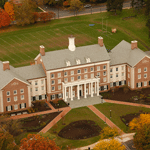Franklin & Marshall College in Lancaster, Pennsylvania, was established with a gift from Benjamin Franklin in 1787. More than two hundred years later, the school has committed to achieve LEED Silver certification on all major renovations and new facilities that exceed 5,000 square feet. The first of such new construction projects since the new sustainability plan at the 2,400-student college is New College House.
Given its age and history, Franklin & Marshall wanted even new buildings to evoke a classic, historic look. New College House was built in the tradition of architect Charles Z. Klauder, an American architect who lived in the late 1800s and early 1900s, who was known for Georgian buildings with red brick, stone, painted wood trim, and slate roofs.
The college broke ground on the project in 2009, completed it in May 2011 and received its LEED Silver certification in October 2012. The 188-bed facility offers suites, apartments, and dorm rooms, as well as a multipurpose space, seminar and small group rooms, and offices. The design incorporates energy-recovery units in its HVAC system, local and regional building materials, FSC-certified wood, and materials with a high recycled content.
The most notable aspect of the project is its six rain gardens that manage rainwater on-site. “Because of the placement of this building, we had to deal with storm water,” says Mike Wetzel, associate vice president of facilities management and campus planning. “The City of Lancaster has an older system, and it’s at capacity in terms of storm-water management. We had to come up with a way that was friendly to the environment.”
One option was to tap into a nearby township, but officials there were asking for a $250,000 tapping fee. Instead, Franklin & Marshall’s architects worked with landscape architects to design rain gardens for the project.
“Four huge rain gardens are in front of the building,” Wetzel says. “And two in back are interconnected. They handle all of the storm water that comes off of the building and an adjacent site. We’ve had significant storms since construction was completed, and in 24 hours or less, buildup from the storm infiltrates into the ground.”
A parking lot built nearby was constructed to also handle water flow because in the past, rain would flood off the parking lot and onto nearby streets. Rain gardens were added to the lot, and permeable pavement was chosen for its porous abilities. “By using porous pavement for parking spaces and impervious paving for the driving areas, we solved the problem,” Wetzel says. “The parking lot has become a model for our city and county because of how well it has performed.”
With its first sustainable initiative in place, Franklin & Marshall College is using New College House and the new parking lot as concrete examples of the college’s commitment to sustainability.

